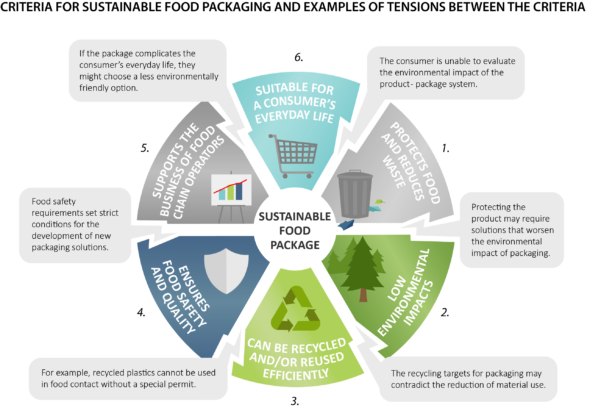The European Union wants food packages to be recyclable and reusable
Europe produces nearly 30 million tonnes of plastic waste annually, and the amount is increasing. Food packaging accounts for almost 60% of the plastic waste produced. The European Union’s (EU) 2018 plastics strategy sets a target that all plastic packaging used in the Union will be either reusable or easily recyclable by 2030. The same objective is also included in the EU Circular Economy Action Plan updated in 2020. In addition, the 2019 Single-Use Plastics Directive aims to reduce the consumption of single-use plastic products, including the packaging of ready-to-eat food, and to ban a number of products containing plastics in the EU.
The EU’s objectives of reducing plastic waste and promoting circular economy require changes in food packaging. These objectives bring new requirements and growth opportunities to European operators in food production, retail trade and the packaging industry. We present six criteria for sustainable food packaging and the tensions between them to support both political and corporate decision-making.
The risk of transferring negative environmental impacts elsewhere
Packaging is an essential part of a functioning and safe food system in today’s long global food chains. Appropriate packaging protects food during transport and storage and thus reduces food waste and the resulting CO2 emissions.
The environmental impact of food production is often notably higher than that of producing and recycling packaging. However, some policy measures aimed at reducing the environmental load of packaging do not take into account the functional role of packaging in the food chain.
Packaging plays an essential role in the food chain. Reducing the consumption of packaging materials and packages and promoting recycling should be implemented in such a way that it does not create new disadvantages elsewhere as a by-product, following an increased amount of food waste, for example.
The functionality of packaging determines sustainability
The updated EU Circular Economy Action Plan, published in March 2020, sets out an objective that sustainability principles for products and their design will guide wider political and legislative development in the future. What could this mean for food packaging?
Currently, the environmental impacts of food and food packaging are largely measured by separate indicators, which do not usually take the functionality of the packaging into account.
Defining the sustainability criteria for food packages requires further knowledge on how changes in packaging promote or hinder the various sustainability targets set for the food system. Criteria is needed to support the packaging industry’s opportunities to develop new and more environmentally friendly solutions.
Sustainability criteria for food packaging
The sustainability of food packaging can refer to ecological, economic, social and cultural sustainability. The sustainability evaluation should consider not only the packaging, its production and raw material chains, but also its significance in the context of food production, distribution, consumption and waste management. The purpose of food packaging is to protect the product in the logistic chain, shops and households and to avoid food waste and loss. The packaging should also facilitate food chain operators’ and consumers’ everyday life, fit waste management and recycling systems without problems, and be cost and resource efficient.
The criteria for sustainability may conflict with each other. An action that promotes an individual sustainability target for food packaging may also hinder achieving another sustainability target. In order to make justified choices, decision-makers must be familiar with the operating environment of food packaging and the conflicts and interdependencies between the different sustainability criteria.
Criteria for sustainable food packaging
- PROTECTS FOOD AND REDUCES WASTE: The functional purpose of a package is to protect the food. This contributes to reducing food waste and the environmental impacts of the food production chain. Different packaging materials and processes are required to achieve this functional target. Each of these materials have their own environmental impacts.
- THE ENVIRONMENTAL IMPACT OF PACKAGING IS LOW: The environmental impacts in the life cycle of food packaging are significantly influenced by the quality, quantity and origin of the packaging material used, as well as the post-use phases and recovery of packaging. Food packaging may consist of different materials, such as fossil or bio-based plastics, fibre-based materials, metals, glass and different composite materials. Plastic packaging is considered problematic mainly due to terrestrial and aquatic littering, the microplastics problem, and the use of fossil materials. Bio-based packaging materials, including bio-based plastics, have their own environmental impacts. Biomaterial production may involve changes in land and water use, biodiversity, soil’s carbon stock and eutrophication.
- PACKAGING CAN BE RECYCLED AND/OR REUSED EFFICIENTLY: Reducing plastic packaging waste is particularly important. Therefore, the efficient recyclability and reusability of packaging materials and packages are key criteria for sustainable food packaging. The reuse of plastic food packages is still not common, but there are some companies that offer reuse solutions. On the other hand, the collection and recycling of plastic waste has increased significantly in recent years. Most plastic waste is recycled mechanically. Other recycling methods include chemical and biological (biodegradable materials) recycling.
- PACKAGING ENSURES THE SAFETY AND QUALITY OF FOOD: Ensuring food safety is one of the most important tasks of a food package. Therefore, food packaging materials are regulated and controlled thoroughly in the EU. In addition to protecting the food from contamination that endangers health, the packaging should also ensure that the taste and structure of the food remains as good as possible.
- PACKAGING SUPPORTS THE BUSINESS OF FOOD CHAIN OPERATORS: Economically sustainable food packaging promotes the business of food chain operators. Such packaging is designed to be material and cost effective so that it protects the product and enables cost-effective transport, storage and handling. The package also informs consumers about the product, its shelf-life, product safety and sustainability, and promotes the product’s sales in shops. On the other hand, the packaging should not tempt consumers to consume beyond their need.
- PACKAGING IS SUITABLE FOR THE CONSUMER’S EVERYDAY LIFE: Culturally sustainable packaging is suitable for the consumer’s everyday life. It is easy to use, store, recycle and available for the right price. Cultural sustainability is a prerequisite for consumers to accept and use new packaging and recycling solutions. The consumer perspective is easily overshadowed by technical perspectives in packaging development, and involving consumers in decision-making would support promoting cultural sustainability.
Click the infograph to open in bigger format.
Tensions between criteria
The environmental impacts in the life cycle of a package must always be proportionate to the package’s functional purpose. While the protection of the product may require solutions that increase an individual environmental impact of the packaging, the overall environmental impact of the product-package system is reduced.
Recycling targets for plastic food packages may contradict other environmental objectives, such as the use of materials or the reduction of consumption. For example, multi-layer plastics, which are often used in food packaging, are difficult to recycle, while plastic packaging that is easy to recycle may contain more material. Likewise, biodegradable plastics can cause problems in mechanical plastic recycling.
Food safety sets strict demands for food packaging. It may not be easy to meet the requirements of food contact materials regulation and simultaneously reach the packaging recycling targets set by the EU’s plastics strategy. According to current practice, recycled plastic cannot be used in food contact without a special permit, for example.
If a package complicates the consumers’ everyday life, they might choose a less environmentally friendly option. From a consumer’s perspective, a badly designed food package is difficult to use, does not adequately protect the food or inform of the product’s properties, and/or it is difficult to sort and recycle.
Although a purpose of the packaging is to promote and market the product, it is also a question of costs for the company. The introduction of new packaging solutions may be expensive and risky for the brand and the product’s demand. The food safety requirements for packaging materials are strict. This increases the risk and costs of developing new packaging solutions.
Sustainable packaging should fulfil its purposes serving the food system with minimal environmental burden and reasonable costs. Companies, authorities and policymakers need evaluation tools to be able to make informed choices that acknowledge the impacts on the different criteria for the sustainability of food packaging.

